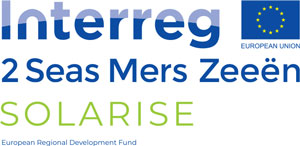Guidelines for overcoming technical, legal, economic and social barriers to increased solar energy (project output 1)
The study looks at different aspects, like: solar energy market analysis, legal issues and future potential; solar energy harvesting cost and investment models; technical aspects of hybrid PV/T systems; innovative solar technologies; smart grids; guidelines for benchmarking and pilots; and best practices.
The result of this guide package is a comprehensive report, and a webinar where the findings were presented.
- The resulting document of the study
- The webinar in january 2020 to present the guidelines
- The webinar in january 2020 to present the guidelines (Dutch)
- A poster summary
Feasibility studies of Potential solar projects (project output 2)
This document is a guide package reporting on the diversity of solar energy applications cases, including historical buildings, public buildings, municipal housing, living labs, and solar farms
A common methodology for feasibility studies of each case of application has been developed in this project. The information related to the diversity of application cases for the successful deployment of solar energy harvesting is gathered in 6 factsheets.
- The resulting document on Studies of Potential Solar Projects
- Video presentation on Studies of Potential Solar Projects
Solarise pilots in historical buildings and public infrastructure (project output 3)
Pilot project are used to prove that a given technology works in a given environment. They are used as a showcase to inspire similar deployments. Lessons learned during the project will be shared, so that following project can be realised more easily.
Within Solarise solar installations on non-typical buildings are showcased. Most of them have to find solutions to respect the heritage value of a historical building. Two other pilots are specific regarding their business case.
- Middelburg public building De Helm heated by invisible solar tubes (NL)
- Middelburg historic building Zeeland Archives powered by Solar PV (NL)
- Middelburg historic building Zeeland Concert Hall powered by Solar PV (NL)
- Heritage mill in Leffinge, Middelkerke (BE)
- A new municipality hall for Halle-Zoersel (BE)
- Fourmies public building Ecole Aragon (FR)
- Fourmies public buildings – sports complexes: Gymnase Léo Lagrange and Gymnase Marie-José Pérec (FR)
Solarise pilots in housing (project output 4)
Within Solarise different approaches for solar installations on multi tenant social apartment blocks were showcased.
- Brighton & Hove Apartment building Elwyn Jones Court (UK)
- Brighton & Hove Apartment building Oxford Street (UK)
- Brighton & Hove Social housing flats Buckley Close (UK)
Solarise Living Labs (project output 5)
Living labs are defined as user-centered, open innovation ecosystems based on a systematic user co-creation approach integrating research and innovation processes in real-life settings. The key stakeholders of a universitybased living lab are academic staff, researchers, students, and external partners. A living lab provides the opportunity for staff and students to build solutions that directly address immediate real-world problems and to analyse the behaviour of real systems as they operate.
On the universities of 3 countries, a living lab was built within the project:
- University of Portsmouth – Living lab (UK)
- University of Picardie Jules Verne Amiens – Living lab SOLLAB (FR)
- KU Leuven Technology Campus Ghent – Living lab (BE)
Roadmap for Solar energy as a premise of the Energy Transition Plan (project output 6)
A solar road map creates a strategy and a delivery plan to accelerate the use of solar energy in a defined area. It is usually created by local government organisations and often part of an Energy Plan which considers broader issues of energy demand and other renewable energy technologies and targets.
This methodology is a guide to help organisations to create their own Solar Road Map. It will help you to consider the actions and issues needed to create a Solar Road Map, according to your local circumstances, resources and objectives. Use the points which are most relevant for your area. The methodology is applied to 6 cities/municipalities as examples.
